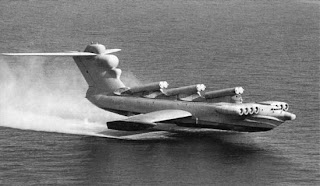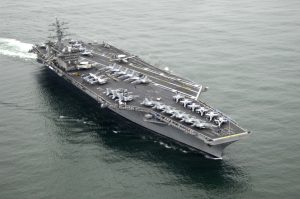 During the mid-1960s chilly height of the Cold War, US photo reconnaissance spotted a strange apparition on the shores of the Caspian Sea – a gigantic 100m-long aircraft with inexplicably truncated square wings. US Intelligence dubbed the beast the “Caspian Sea Monster”, unaware that the Russians were developing not, as they thought, an enormous conventional seaplane, but rather a 550-ton water-hugging behemoth designed to use the ground effect to skim the ocean at high speed, undetected by radar.
During the mid-1960s chilly height of the Cold War, US photo reconnaissance spotted a strange apparition on the shores of the Caspian Sea – a gigantic 100m-long aircraft with inexplicably truncated square wings. US Intelligence dubbed the beast the “Caspian Sea Monster”, unaware that the Russians were developing not, as they thought, an enormous conventional seaplane, but rather a 550-ton water-hugging behemoth designed to use the ground effect to skim the ocean at high speed, undetected by radar.
The Russians had a rather more prosaic name for the Caspian Sea Monster: the KM or “korabl-maket”. This “ship-prototype” was the first in a series of Soviet “ekranoplan” (“screen plane”) developments and was designed by Rostislav Evgenievich Alexeev of the Central Hydrofoil Design Bureau. The KM was intended as a test platform to examine the possibilities of the “Wing In Ground” (WIG) effect whereby (in very simple terms) a wing traveling close to the ground is provided with extra lift by the “cushion” of air compressed under it – thereby enabling a combination of greater aircraft weight for less power and/or enhanced fuel economy.
 The KM, powered by eight Dobryin VD-7 turbojets on the front of the fuselage, and two on the tail for extra thrust during take-off, first took to the air in October 1966. During its extensive test career, it was continually modified. The wingspan was altered to between 32m and 40m, and the length varied from 92m to 106m.
The KM, powered by eight Dobryin VD-7 turbojets on the front of the fuselage, and two on the tail for extra thrust during take-off, first took to the air in October 1966. During its extensive test career, it was continually modified. The wingspan was altered to between 32m and 40m, and the length varied from 92m to 106m.
The KM crashed in 1980, apparently due to the pilot ill-advisedly attempting to take off without giving it full throttle. An attempt to recover the leviathan from the depths was thwarted by its vast weight.
The A-90 OrlyonokWhile the KM program was ongoing, Alexeev began work on a medium-sized ekranoplan suitable for military transportation duties. Dubbed A-90 “Orlyonok” (“Eaglet”), the 140 tonne, 58 metre long aircraft had its maiden flight in 1972. The A-90 boasted two turbojets and one turboprop engine which propelled it to a speed of 400 km/h for 1,500 km at an cruise altitude of 5-10 m.
Four flying examples were built, one of which crashed in the Caspian in 1975 and was subsequently rebuilt. The aircraft entered military service in 1979 with three A-90s reportedly  still operational in 1993. Thereafter, they were reportedly mothballed at the Kaspiysk naval base on the Caspian.
still operational in 1993. Thereafter, they were reportedly mothballed at the Kaspiysk naval base on the Caspian.
During the Cold War, ekranoplans were sighted for years on the Caspian Sea as huge, fast-moving objects. The name Caspian Sea Monster was given by US intelligence operatives who had spotted the huge vehicle, which looked like an airplane with the outer halves of the wings removed. After the end of the Cold War, the “monster” was revealed to be one of several Soviet military designs meant to fly only a few meters above water, saving energy and staying below enemy radar.


